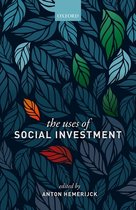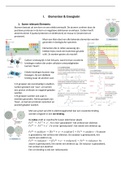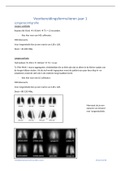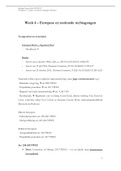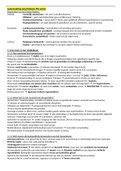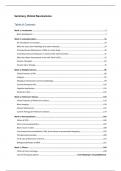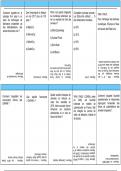Hannah van Dijk – Social Risks in Europe – 201700151
Articles week 1
Bambara (2007)
Aim of paper: Give public health researchers an overview of the welfare state regime literature
So that it can be reflected more accurately in future research
Differences in health outcomes between / within countries can be explained / examined by comparing
different types of welfare state regimes + politics and policies
Typology of welfare stat regimes = The three worlds of welfare capitalism: Proposed by Esping-
Andersen (1990): A typology of 18 Organization of Economic Cooperation and Development (OECD)
welfare states based on three principles:
1- Decommodification = Extent to which an individual’s welfare is reliant upon the market
(pensions / unemployment benefits / sickness insurance)
2- Social stratification = Role of welfare states in maintaining or breaking down social
stratification
3- The private-public mix = Relative roles of the state, the family, the voluntary sector and the
market in welfare provision
Using these principles, welfare states can be divided into three ideal regime types:
1- Liberal = State provision of welfare is minimal, benefits modest and recipients are usually
means-tested and stigmatized (Australia, Canada, Ireland, NZ, UK, USA)
2- Conservative = Status differentiating welfare programs with benefits that are earnings-related,
administered through the employer and geared towards maintaining existing social patterns
(Finland, France, Germany, Japan, Italy, Switzerland)
3- Social Democratic = Universal and comparatively generous benefits, a commitment to full
employment and income protection and a strongly interventionist state to promote equality
through a redistributive social security system (Austria, Belgium, NL, Denmark, Norway,
Sweden)
Theoretical critiques
Esping-Andersen only looked at 18 countries If he would have looked at Spain / Portugal for
example, there would have been a fourth world of welfare
Also: If he would have looked at East Asian welfare states, he would have found a further
Confucian welfare state regime, characterized by low levels of government intervention and
investment in social welfare + underdeveloped public service provision + high importance of
family and voluntary sector in providing social safety nets
Castles & Mitchell (1993) found that the UK, Australia and NZ have a radical and targeted form of
welfare state: Here the welfare goals of, for example, income equality are not pursued through high
expenditure levels (rather through redistributive instruments)
The three worlds of welfare capitalism typology was gender-blind, three critiques: (1) The gender-
blind concept of decommodification, (2) the unawareness of the role of women and the family in the
provision of welfare and (3) the lack of consideration given to gender as a form of social stratification
Welfare states are also about the delivery of services such as healthcare, education or social services
(not only about social transfers such as pensions / sickness benefits)
Critiques question the validity of the regime concept because it assumes most key social
policy areas within a welfare regime will reflect a similar approach to welfare provision + it
assumes that each regime type itself reflects a set of principles or values that establishes a
coherence in each country’s welfare package
Researchers have found it more useful to analyze “political” regimes, instead of focusing on welfare
states
, Hannah van Dijk – Social Risks in Europe – 201700151
Methodological issues
Esping-Andersen’s methodology has limitations as well: He used one standard deviation around the
mean to classify the countries into regimes, which meant only a threefold classification was possible:
Regime classification is either above [Social Democratic], below [Liberal] or within
[Conservative] one standard deviation around the mean
For example, if a different cut-off point was used the UK would not have fallen in the Liberal regime
Empirical validity
Esping-Andersen’s study was replicated, and the results differed substantially from the original
Also, there was a miscalculation of the mean and the standard deviation in the original data Led to
a misclassification of three borderline countries (Ireland / UK / Japan)
Also, the relationships between the 18 OECD countries have changed significantly and the
composition of welfare state regimes is not static
This paper suggests that more awareness of wider regimes is needed + going beyond the three worlds
of welfare capitalism will be useful
Also: More critical engagement with the concept of regimes is needed
Further research could examine the competing typologies and establish which works best in terms of
health outcomes and public health research
, Hannah van Dijk – Social Risks in Europe – 201700151
Hemerijck (2017) Chapter 1
In 2013 the EU launched the Social Investment Package for Growth and Social Cohesion
Meant to invest in human capital and capabilities from early childhood through old age
Instead of repairing damages after economic/personal crisis’
Lately: There are doubts to the claim that active social investment is better than passive social
insurance spending
Social investment has Matthew Effects = The middle class disproportionally benefits from social
investments at the expense of the worst off
Social investment started after mid-1990. The reason was to modernize the welfare state and ensure its
long-term sustainability, in the face of demographic ageing, by making social policy systems more
employment-friendly
- First there was a misconception that social policy interventions go at the expense of economic
competitiveness But this misconception was exposed
Esping-Andersen: Economic sustainability (of welfare states) depends on the number / productivity of
future employees and taxpayers
Five important intellectual innovations in social policy research that showed a new welfare state was
needed:
1- The changing nature of social risks
o Pension systems were hurt due to: Population ageing, declining fertility and early
retirement of baby-boomers
o Also: There has been a shift towards post-industrial labor markets Reduced
demand for low-skill work: Deindustrialization has reduced the number of steady
lifetime jobs
o More female labor-market participation New demands for social care for children
and elderly
2- A novel assessment of the carrying capacity of the welfare state
o Myles (2002) created a cost-benefit equation for sustainable pension systems:
o There are more non-actuarial risks in the competitive knowledge economy
o The welfare state’s social spending comes from a larger, more productive and less
socially scarred workforce
Investing in children (through for example good education and childcare)
lead to the achievement of a sustainable welfare state
3- The imperative of evaluating welfare provision from a dynamic life-course perspective
o People are vulnerable at four points in life: (1) moving from education to first job, (2)
having children, (3) when they experience spells of labor market inactivity and (4)
when they move to retirement
4- The intimately related dimension of family demography and gender role change
o Parenthood should be made compatible with a life dedicated to work and career
o A more egalitarian equilibrium between men’s and women’s lives must be created
5- An updated normative conception of capacitating social justice
o There is a high need for social participation and inclusion
Heckman: There is no consensus about the relationship between social policy and economic
performance: It is hard to find a causal link between welfare states and economic performance
, Hannah van Dijk – Social Risks in Europe – 201700151
A more consolidated (old and new) social risk management is needed: Considers policies beyond
active social investment priorities
Three central interdependent social investment policy functions:
1- Raising the quality of the stock of human capital and capabilities over the life course
2- Easing the flow of contemporary labor-market and life-course transitions
3- Maintaining strong minimum-income universal safety nets as income protection and economic
stabilization buffers in ageing societies
Stock = Linked to present and future productivity: Goal is to enhance and maintain human capital /
capabilities over the life course in ageing societies
Flow = Directed at making the most effective use and efficient allocation of labor resources over the
life course in support of high employment participation
Buffer = Aims at securing income protection and securing economic stabilization
Stock, flow and buffer all affect each other and affect the quality and quantity of labor supply
Example: Early childhood development + care parental employment flow and improved
household income buffers and reduced chance of poverty + investment in the future human
capital stock of current cohorts of children
Articles week 1
Bambara (2007)
Aim of paper: Give public health researchers an overview of the welfare state regime literature
So that it can be reflected more accurately in future research
Differences in health outcomes between / within countries can be explained / examined by comparing
different types of welfare state regimes + politics and policies
Typology of welfare stat regimes = The three worlds of welfare capitalism: Proposed by Esping-
Andersen (1990): A typology of 18 Organization of Economic Cooperation and Development (OECD)
welfare states based on three principles:
1- Decommodification = Extent to which an individual’s welfare is reliant upon the market
(pensions / unemployment benefits / sickness insurance)
2- Social stratification = Role of welfare states in maintaining or breaking down social
stratification
3- The private-public mix = Relative roles of the state, the family, the voluntary sector and the
market in welfare provision
Using these principles, welfare states can be divided into three ideal regime types:
1- Liberal = State provision of welfare is minimal, benefits modest and recipients are usually
means-tested and stigmatized (Australia, Canada, Ireland, NZ, UK, USA)
2- Conservative = Status differentiating welfare programs with benefits that are earnings-related,
administered through the employer and geared towards maintaining existing social patterns
(Finland, France, Germany, Japan, Italy, Switzerland)
3- Social Democratic = Universal and comparatively generous benefits, a commitment to full
employment and income protection and a strongly interventionist state to promote equality
through a redistributive social security system (Austria, Belgium, NL, Denmark, Norway,
Sweden)
Theoretical critiques
Esping-Andersen only looked at 18 countries If he would have looked at Spain / Portugal for
example, there would have been a fourth world of welfare
Also: If he would have looked at East Asian welfare states, he would have found a further
Confucian welfare state regime, characterized by low levels of government intervention and
investment in social welfare + underdeveloped public service provision + high importance of
family and voluntary sector in providing social safety nets
Castles & Mitchell (1993) found that the UK, Australia and NZ have a radical and targeted form of
welfare state: Here the welfare goals of, for example, income equality are not pursued through high
expenditure levels (rather through redistributive instruments)
The three worlds of welfare capitalism typology was gender-blind, three critiques: (1) The gender-
blind concept of decommodification, (2) the unawareness of the role of women and the family in the
provision of welfare and (3) the lack of consideration given to gender as a form of social stratification
Welfare states are also about the delivery of services such as healthcare, education or social services
(not only about social transfers such as pensions / sickness benefits)
Critiques question the validity of the regime concept because it assumes most key social
policy areas within a welfare regime will reflect a similar approach to welfare provision + it
assumes that each regime type itself reflects a set of principles or values that establishes a
coherence in each country’s welfare package
Researchers have found it more useful to analyze “political” regimes, instead of focusing on welfare
states
, Hannah van Dijk – Social Risks in Europe – 201700151
Methodological issues
Esping-Andersen’s methodology has limitations as well: He used one standard deviation around the
mean to classify the countries into regimes, which meant only a threefold classification was possible:
Regime classification is either above [Social Democratic], below [Liberal] or within
[Conservative] one standard deviation around the mean
For example, if a different cut-off point was used the UK would not have fallen in the Liberal regime
Empirical validity
Esping-Andersen’s study was replicated, and the results differed substantially from the original
Also, there was a miscalculation of the mean and the standard deviation in the original data Led to
a misclassification of three borderline countries (Ireland / UK / Japan)
Also, the relationships between the 18 OECD countries have changed significantly and the
composition of welfare state regimes is not static
This paper suggests that more awareness of wider regimes is needed + going beyond the three worlds
of welfare capitalism will be useful
Also: More critical engagement with the concept of regimes is needed
Further research could examine the competing typologies and establish which works best in terms of
health outcomes and public health research
, Hannah van Dijk – Social Risks in Europe – 201700151
Hemerijck (2017) Chapter 1
In 2013 the EU launched the Social Investment Package for Growth and Social Cohesion
Meant to invest in human capital and capabilities from early childhood through old age
Instead of repairing damages after economic/personal crisis’
Lately: There are doubts to the claim that active social investment is better than passive social
insurance spending
Social investment has Matthew Effects = The middle class disproportionally benefits from social
investments at the expense of the worst off
Social investment started after mid-1990. The reason was to modernize the welfare state and ensure its
long-term sustainability, in the face of demographic ageing, by making social policy systems more
employment-friendly
- First there was a misconception that social policy interventions go at the expense of economic
competitiveness But this misconception was exposed
Esping-Andersen: Economic sustainability (of welfare states) depends on the number / productivity of
future employees and taxpayers
Five important intellectual innovations in social policy research that showed a new welfare state was
needed:
1- The changing nature of social risks
o Pension systems were hurt due to: Population ageing, declining fertility and early
retirement of baby-boomers
o Also: There has been a shift towards post-industrial labor markets Reduced
demand for low-skill work: Deindustrialization has reduced the number of steady
lifetime jobs
o More female labor-market participation New demands for social care for children
and elderly
2- A novel assessment of the carrying capacity of the welfare state
o Myles (2002) created a cost-benefit equation for sustainable pension systems:
o There are more non-actuarial risks in the competitive knowledge economy
o The welfare state’s social spending comes from a larger, more productive and less
socially scarred workforce
Investing in children (through for example good education and childcare)
lead to the achievement of a sustainable welfare state
3- The imperative of evaluating welfare provision from a dynamic life-course perspective
o People are vulnerable at four points in life: (1) moving from education to first job, (2)
having children, (3) when they experience spells of labor market inactivity and (4)
when they move to retirement
4- The intimately related dimension of family demography and gender role change
o Parenthood should be made compatible with a life dedicated to work and career
o A more egalitarian equilibrium between men’s and women’s lives must be created
5- An updated normative conception of capacitating social justice
o There is a high need for social participation and inclusion
Heckman: There is no consensus about the relationship between social policy and economic
performance: It is hard to find a causal link between welfare states and economic performance
, Hannah van Dijk – Social Risks in Europe – 201700151
A more consolidated (old and new) social risk management is needed: Considers policies beyond
active social investment priorities
Three central interdependent social investment policy functions:
1- Raising the quality of the stock of human capital and capabilities over the life course
2- Easing the flow of contemporary labor-market and life-course transitions
3- Maintaining strong minimum-income universal safety nets as income protection and economic
stabilization buffers in ageing societies
Stock = Linked to present and future productivity: Goal is to enhance and maintain human capital /
capabilities over the life course in ageing societies
Flow = Directed at making the most effective use and efficient allocation of labor resources over the
life course in support of high employment participation
Buffer = Aims at securing income protection and securing economic stabilization
Stock, flow and buffer all affect each other and affect the quality and quantity of labor supply
Example: Early childhood development + care parental employment flow and improved
household income buffers and reduced chance of poverty + investment in the future human
capital stock of current cohorts of children


